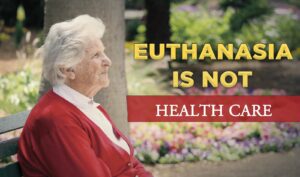
“I’m 28. And I’m scheduled to die in May.” That heartbreaking statement came from a lovely young woman in the Netherlands named Zoraya ter Beek who plans to have a physician kill her just weeks from now. Why is she planning to die by lethal injection? Is she terminally ill? No, the reason, she states, is because she’s “hobbled by her depression and autism and borderline personality disorder.” As the Free Press reports, despite being in love with her boyfriend and living in a nice house with their two cats, she is tired of living – at 28 years old.
The Free Press goes on to report: “She recalled her psychiatrist telling her that they had tried everything, that ‘there’s nothing more we can do for you. It’s never gonna get any better.’ At that point, she said, she decided to die.” Here’s a picture of Zoraya.
 This tragic account is not isolated, but is happening by the thousands in countries where individuals are offered death instead of hope and help. Physicians are now encouraging patients to pursue euthanasia, seemingly, because it’s easier than treating them. As the reporter in the story above states: “Zoraya ter Beek is one of a growing number of people across the West choosing to end their lives rather than live in pain. Pain that in many cases can be treated.”
This tragic account is not isolated, but is happening by the thousands in countries where individuals are offered death instead of hope and help. Physicians are now encouraging patients to pursue euthanasia, seemingly, because it’s easier than treating them. As the reporter in the story above states: “Zoraya ter Beek is one of a growing number of people across the West choosing to end their lives rather than live in pain. Pain that in many cases can be treated.”
Euthanasia is a growing cause of death, where it has been legalized. In the Netherlands, as of 2022, euthanasia accounts for one out of every 20 deaths. In Switzerland, physician-assisted suicide increased 11% last year; in Belgium, death by lethal injection went up 15%. Euthanasia is also legal in Canada, Colombia, Luxembourg, the New Zealand and Spain, as well as several states in Australia. Physician-assisted suicide has also been legalized in numbers of U.S. states – more on that below, including troubling ramifications for Michigan.
In Canada, which has the infamous “Medical Assistance in Dying” (MAID) program, euthanasia has “grown at a speed that outpaces every other nation in the world,” the Toronto Star reports. One out of every 25 deaths in Canada is the result of physician-assisted suicide – the fifth-leading cause of death. However, it’s now impossible to track how many Canadians are dying from assisted suicide because if someone seeks physician-assisted suicide due to a cancer diagnosis, cancer will now be listed as the cause of death – not euthanasia.
In addition, Canada also leads the world with the most permissive assisted suicide protocols. Canadians can now receive lethal injection if they’re suffering from issues such as depression, anorexia, chronic pain, mental illness, or disability. A pro-euthanasia group in Canada is also lobbying the government to expand assisted suicide to children as young as 12 while the Quebec College of Physicians is advocating for killing babies through assisted “suicide” up to age one who are born with “severe malformations” and “grave and severe syndromes.”
When the MAID law was instituted in Canada in 2016, Prime Minister Justin Trudeau dismissed concerns that it would become a slippery slope. City Journal’s Michael Bonner writes, “When critics argued that the ruling would result in euthanasia being offered to the mentally ill, the depressed, those with disabilities, or other vulnerable persons, Prime Minister Justin Trudeau dismissed such concerns, saying, ‘this simply isn’t something that ends up happening.'”
And yet eight years later, it has happened. As City Journal goes on to report: “In 2021, Parliament removed the law’s previous requirement that a person’s natural death must be imminently foreseeable for him to elect suicide. Reports immediately began circulating of physicians pushing MAID on people who had suffered strokes or other survivable challenges. These people were isolated and depressed in many cases, but hardly at death’s door. In one alarming instance, a 71-year-old widower was admitted to hospital after a fall. He contracted infectious diarrhea in hospital, where he was humiliated by staff for the smell of his room. Staff claimed that he had end-stage COPD and offered him MAID; he took their advice and was euthanized within 48 hours of his first assessment. A post-mortem examination, however, proved that he did not have end-stage COPD.”
 Canada’s euthanasia program doesn’t “distinguish between medical infirmities and avoidable suffering caused by neglect or poverty,” Bonner also writes. It’s also now argued that Canadians should be able to receive assisted suicide if “living conditions make their lives intolerable.” The philosophy of the Canadian government seems to echo that of Ebenezer Scrooge in Charles Dickens’ A Christmas Carol – let the poor die and “decrease the surplus population.”
Canada’s euthanasia program doesn’t “distinguish between medical infirmities and avoidable suffering caused by neglect or poverty,” Bonner also writes. It’s also now argued that Canadians should be able to receive assisted suicide if “living conditions make their lives intolerable.” The philosophy of the Canadian government seems to echo that of Ebenezer Scrooge in Charles Dickens’ A Christmas Carol – let the poor die and “decrease the surplus population.”
Doctors have offered suicide to Canadians who can’t afford housing, veterans who are struggling financially, those who are on months-long waiting lists for medical care, or simply because it’s less expensive and more convenient for Canada’s government-run healthcare system to offer patients death rather than care.
It all comes down to dollars and cents. Back in 2017, the Canadian Broadcast Network reported that “medically assisted dying could result in substantial savings across Canada’s health-care system,” reducing Canada’s healthcare costs by millions. It’s cheaper to kill than to cure.
Here in the U.S., ten states plus Washington, D.C. have legalized physician-assisted suicide. In an effort to negate their complicity, U.S. physician-assisted suicide involves doctors prescribing a lethal dose of pills for a patient to take at home. Yet that doesn’t wash the blood off the hands of doctors who betray the Hippocratic Oath to “do no harm.” The physician’s Hippocratic oath goes back centuries before Christ and includes this sentence: “Nor shall any man’s entreaty prevail upon me to administer poison to anyone. Neither will I counsel any man to do so. Moreover, I will give no sort of medicine to any pregnant woman with a view to destroy the child.”
My home state of Michigan will be the 11th state to legalize doctor-assisted suicide, if Senate Bills 678-681 become law. This so-called “Death with Dignity Act” would supposedly limit assisted suicide to terminally ill adults with fewer than six months to live. However, Canada once had those same “safeguards.” Now just eight years later they’re killing vulnerable people with depression and anorexia. The slippery slope is very real.
One thing standing in the way of these bills being pushed through the Michigan legislature is a deadlocked House, tied at 54-54, after two Democrat state representatives left office last November. Their seats will be filled in a special election on April 16 for Michigan House Districts 13 and 25. Pray that at least one Republican will win one of these seats to keep this deadly legislation at bay. And if you live in one of these districts, be sure to vote. Or if you know others who live in these districts, encourage them to vote.
A Michigan ballot proposal in1998 which sought to legalize assisted suicide failed as 7 out of 10 Michiganders rejected it. However, in 2022, less than 25 years later, an overwhelming majority of Michigan voters approved a ballot proposal legalizing abortion up to the moment of birth. The moral foundations that once upheld our society have rapidly disintegrated.
It’s interesting that nearly 80 years after it’s filming, “It’s a Wonderful Life” is still one of America’s most beloved Christmas movies – a Christmas movie dealing with suicide. You more than likely know the story of George Bailey who also sees suicide as the only way out of his troubles – until Clarence the angel is summoned because, he’s told, George is “thinking seriously of throwing away God’s greatest gift.” In fact, “The Greatest Gift” was the original title of the movie script. “It’s against the law to commit suicide around here,” the tollkeeper says in the film. “It’s against the law where I come from, too,” adds Clarence.
While assisted suicide is no longer against man’s law in many countries, including our own, it will always be against God’s law.
 Our bodies – including our life and our death- belong to God. They are not ours to dispose of as we will. Human beings are created in His image, for His will and for His glory. We were made for God; we are not autonomous beings. The Bible makes clear that the giving and taking of life is God’s right, and euthanasia is an attempt to usurp His authority.
Our bodies – including our life and our death- belong to God. They are not ours to dispose of as we will. Human beings are created in His image, for His will and for His glory. We were made for God; we are not autonomous beings. The Bible makes clear that the giving and taking of life is God’s right, and euthanasia is an attempt to usurp His authority.
Of course, doctors should do all that is possible to relieve human suffering and the advancement of palliative care is a great benefit to many at the end of natural life. Deciding whether to pursue further treatment is also something to be considered. However, there’s a stark difference between comfort at the end of life and causing a life to end.
Death ushers in the greatest consequence for each person, the moment in which one’s final destiny is irrevocably set. (Luke 16:26; Hebrews 9:27) For those who have put their trust in the redeeming work of Christ, we are assured of eternity with the Lord. But what about those who have no hope? (I Thessalonians 4: 13) What about those who are lost in despair and instead of being offered the hope found in Jesus are instead offered death. Euthanasia robs them of the opportunity to hear the good news and find true peace – the peace that passes understanding.
We began with the heart-wrenching story of Zoraya ter Beek, who told the Free Press: “I’m a little afraid of dying, because it’s the ultimate unknown. We don’t really know what’s next — or is there nothing? That’s the scary part.”
Oh, if only someone will tell her before it’s too late! Please pray for Zoraya that she will put her trust in the Lord and Savior, Jesus Christ and find His purpose for her life – a life, I pray, that will last for many years to come.
To view this article in your browser, Click Here
For more information, articles and newsletters, please check out our website at https://americandecency.org/
You can support ADA financially by visiting: https://give.cornerstone.cc/americandecency

Call us:
231-924-4050Email us:
info@americandecency.orgWrite us:
American Decency AssociationCopyright 2025 American Decency